The ability to make a right turn on a red light is a practice ingrained in the driving habits of most Californians. This maneuver saves time and can improve traffic flow, but it also carries important safety considerations. While some potential rule changes might be in discussion for 2024, it’s important to clearly understand the current laws and practices to be a safe and responsible driver in California.
What is the Right Turn on Red Rule?
In basic terms, California’s “right turn on red” rule permits drivers to make a right-hand turn at a red light under these conditions:
- Full Stop: The driver must bring their vehicle to a complete stop before the limit line (if present) or before entering the crosswalk or intersection.
- Check for Traffic: Drivers must carefully yield to all pedestrians and any vehicles with the right-of-way.
- Clear Path: A right turn on red is only allowed when it is safe to do so, meaning there’s no opposing traffic or other hazards present.
Exceptions to the Right Turn on Red Rule
Certain scenarios prohibit right turns on red in California, even if a driver comes to a full stop and checks for traffic. These include:
- “No Turn on Red” Sign: Posted signs always override the general rule.
- Red Arrow: A right turn is never permitted when facing a red arrow signal.
- One-Way Streets: When two one-way streets intersect, it may be permissible to turn right on red (after stopping) when going from a one-way street onto another one-way street. Check for signs as restrictions may apply.
Possible Updates in 2024
Discussions surrounding potential updates to the right turn on red rule in California have been ongoing. Specific areas of interest include:
- Pedestrian and Cyclist Safety: Some advocacy groups are pushing for restrictions on right turns on red in areas with high levels of pedestrian and cyclist activity to enhance their safety.
- Automated Enforcement: Technology like red-light cameras might be used more widely to enforce right-turn-on-red violations, especially those where drivers fail to come to a complete stop.
- Data-Driven Restrictions: Future decisions on changing the rules might be guided by more robust data collection on accidents and near-misses associated with right turns on red.
Safety Considerations
Regardless of current or future laws, drivers should always exercise caution when making a right turn on red. Here are critical safety tips:
- Complete Stops are Essential: Rolling stops increase the risk of collisions. Come to a full stop before checking surroundings.
- Pedestrian Vigilance: Pedestrians always have the right of way, even if they are crossing against a signal. Look carefully for people in crosswalks.
- Cyclist Awareness: Bicycles can appear quickly and may be harder to spot than cars. Check for cyclists in dedicated lanes or sharing the road before turning.
- Limited Visibility: Weather conditions, parked cars, or other obstructions can reduce your field of view. Avoid turning on red if you can’t fully assess the intersection.
The Importance of Being Aware
As of 2024, while there may be proposed rule updates, California still largely permits right turns on red. Here’s why it’s essential to stay informed:
- Changing Laws: Traffic regulations can be modified regularly. Stay updated via the California DMV website or reliable traffic news sources.
- Local Variation: Cities and counties may have the ability to add restrictions on right turns on red in specific areas, so watch for signage.
- Personal Responsibility: Even when permitted, a right turn on red is a driver’s choice. If in doubt, waiting for the light to turn green is always the safest option.
Conclusion
The right turn on red rule in California can be a time-saver but should never come at the cost of safety. By understanding the law, prioritizing pedestrian and cyclist well-being, and approaching red-light intersections with caution, drivers can continue to benefit from this rule while upholding their responsibility for safe driving.












Leave a Reply